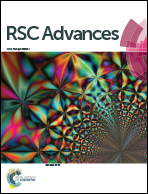Dynamic reversible adhesives based on crosslinking network via Schiff base and Michael addition†
Abstract
It is of practical interest to obtain polymers with complex material properties in a simplified synthetic manner for a broader range of practical applications. In this work, we constructed a dynamic reversible adhesive based on branched polyamine (PA) and p-formylphenyl acrylate (FPA) by simultaneously performing Michael addition reaction and Schiff base reaction. Branched polyamines provide a large number of amino groups as reaction sites that can react with both carbon–carbon double bonds and aldehyde groups. This enables the branched polymeric adhesive system to have a large number of Schiff base bonds within it, an important property of Schiff base bonds is that they are dynamically reversible. This allows us to prepare adhesives with hyperbranched crosslinking networks and recycling properties, and we have verified that FPA–PA adhesives do not exhibit significant fatigue after multiple recycling through the gluing-destruction-gluing process. The resulting FPA–PA adhesives produce tough bonding on multi-substrates such as steel, aluminum, glass, PVC, PTFE, birch and moso bamboo, which exhibited by lap shear strength of 2.4 MPa, 1.7 MPa, 1.4 MPa, 1.3 MPa, 0.4 MPa, 1.6 MPa, and 1.8 MPa, respectively. The feasibility of the synthesis idea of simultaneous Michael addition reaction and Schiff base reaction was demonstrated, as well as the excellent performance and great application potential of FPA–PA adhesives to be recyclable on multi-substrates.



 Please wait while we load your content...
Please wait while we load your content...